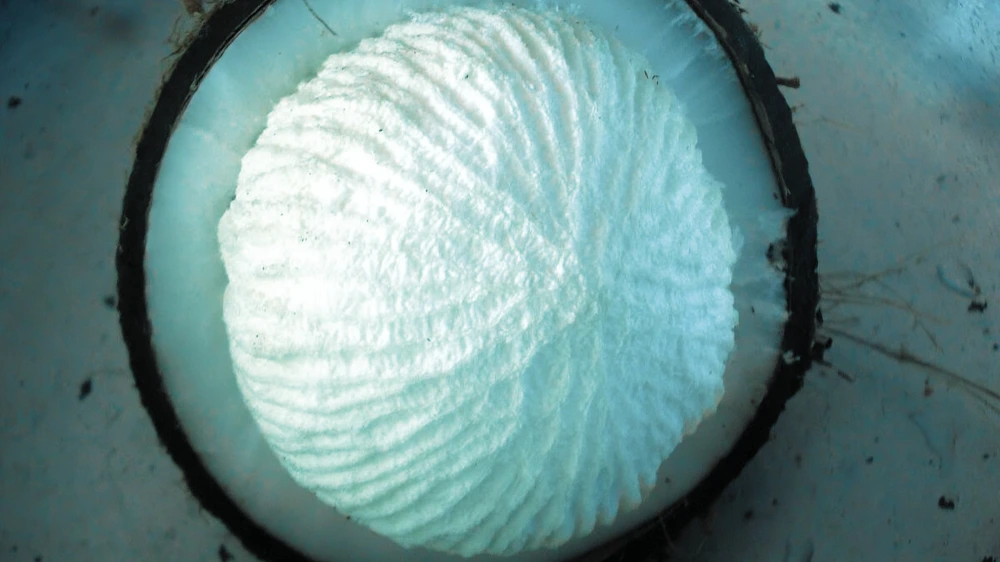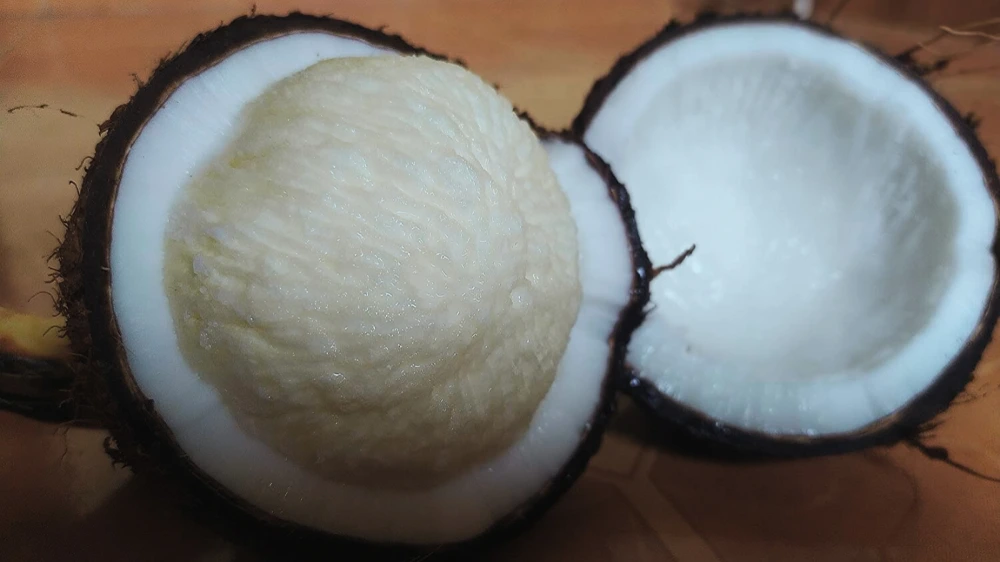Coconut Flower Inside Coconut
Amidst the plethora of delectable delicacies, within the humble coconut, lies a secret treasure: the mysterious coconut flower, sometimes referred to as coconut apple, coconut sprout, or coconut pearl. Though it may not have the same level of popularity as its tropical counterpart, this delicate and delicious fruit has captured people’s tastes and affections for decades, especially in areas where coconuts are numerous, like the coastal districts of South India.
The path to discovering and enjoying the coconut blossom is similar to solving a puzzle in cooking, and it opens up a world of deliciousness and significant health advantages. Imagine finding a coconut, cracked open to show off its creamy flesh and cooling water, but also its soft, spongy center, which tastes like a floral bouquet filled with the essence of the coconut.
Finding this ethereal joy is, for many, a fortuitous experience that brings back memories of youth spent in busy bazaars or amongst the swaying palms of coastal paradises. Just seeing a coconut produce the desired bloom makes me happy and nostalgic, reminding me of carefree pleasures and better days.
In India’s culinary traditions, the coconut flower is especially valued in the southern areas and along the shore. Known as “copra” in Bengali and “kobbari puvvy” in Telugu, this culinary gem is not only a delicious treat but also a representation of life and plenty.
How To Make Coconut Flower And Its Uses
Growing coconut flowers is a labor of love that calls for talent, patience, and a profound awareness of the cycles of the natural world. Mature coconuts are the first to undergo the change, as their husks gradually begin to dry out. After that, these coconuts are partially submerged in soil and given careful attention for four months, during which time small shoots appear and grow under the watchful eye of knowledgeable hands.
These coconuts are carefully dug up when the moment is right, so to speak, and their smooth, bald shells reveal the priceless coconut flower inside. The flower is freed from its cocoon with a delicate touch and an astute eye, ready to be appreciated in all of its beauty.
But it’s not just the coconut flower’s delicious flavor—which has a little hint of coconut flavor—that makes it unique; it also has a host of health advantages. This humble-looking fruit delivers a nutritious punch that belies its lowly beginnings. It is rich in dietary fiber and a variety of vital minerals, including as calcium, potassium, magnesium, manganese, and phosphorus.
The coconut flower is a natural ally for those who are fighting urinary tract infections or trying to keep their hormones in check because it may balance the body’s acidic and alkaline aspects. Additionally, it supports insulin secretion and reduces diabetes symptoms due to its hormone-balancing qualities, providing a comprehensive approach to wellbeing.

The coconut flower appears as a cool haven amid the summer’s intense heatwave, providing electrolyte replenishment, hydration, and body cooling benefits. Fresh or cooked, it’s a sought-after garnish for seasonal dishes because of its natural capacity to ease upset stomachs and fight heat-related illnesses.
The coconut flower is more significant than meets the eye; it is steeped in spiritual meaning and legend. It can be found in one’s kitchen or broken open during a puja ceremony, but either way, it represents a soul awakening and a communion with the world that goes beyond ordinary daily life.
Amidst an abundance of superfoods and unusual cuisines, the coconut flower is a monument to the abundance of nature and the ageless wisdom of traditional cooking methods. Its fascination is found not just in its fleeting beauty or mouthwatering flavor but also in its capacity to nurture the body, mind, and spirit, thus bridging the gap between holistic well-being and gourmet enjoyment.
Therefore, the next time you open a coconut, take a moment to appreciate the ephemeral beauty of the coconut flower. Inside its exquisite petals is a wealth of health and culinary wonders just waiting to be found.
A Frequently Asked Questions (FAQ)
1. Is it OK to eat coconut flower?
In addition to its delicious flavor, the coconut flower offers other advantages. Minerals including calcium, potassium, magnesium, manganese, and phosphorus are abundant in it, along with dietary fiber. It also contains soluble sugars and carbs.
2. What is a coconut flower?
It is the tropical region’s cultural emblem. Most coconut palms flower between the ages of four and six, resulting in a big bud known as a “spathe,” which is a canoe-shaped sheath that can reach a length of three feet. Within the “spathe,” a cluster of flowers is referred to as an inflorescence. Both male and female flowers are carried in the inflorescence.
3. What does coconut flower taste like?
The coconut tree’s blossoms are abundant in nutrients and vitamins. The flower’s sap yields sugar and nectar, and the blooms regrowth occurs every month. It tastes fruity and caramelly instead of at anything like coconut, as one might imagine.
4. What is elusive coconut flower good for?
Coconut flower is beneficial for your bones, brain, and blood sugar levels. Because it replenishes electrolyte storage and keeps the body hydrated, it can be ingested during the heat. Approximately 66% of soluble sugars and 64% of carbs are found in sprouted coconuts.
5. Which part of coconut is not edible?
pericarp
The fruit wall, or pericarp, is inedible non coconuts. An exterior epicarp, a middle fibrous mesocarp, and an inner stony endocarp are the three distinct pericarps.
6. What is special about coconut flower?
Rich in Nutrients: Coconut flowers are a wonderful source of minerals (including iron, calcium, and potassium), vitamins (like vitamin C), and dietary fiber. Antioxidant Properties: They have antioxidants in them that can help shield cells from harm caused by free radicals and oxidative stress.
7. Does coconut flower taste like coconut?
Coconut Flower Nectar tastes nothing like coconut, which is surprising. Our Coconut Syrup has a light savory flavour, more akin to molasses with subtle coconut undertones, while it has a neutral sweet sweetness that makes it a closer match for sugar.
8. Where do coconut flowers grow?
Tropical lowlands along the coast. grows most successfully in warm, humid climates with sandy soils that receive regular rainfall and lots of sunlight.
9. Can I eat coconut flour raw?
Can you consume raw coconut flour? You certainly can. In contrast to almond flour, coconut flour is made from dried coconut meat that has been roasted to a temperature higher than 170F (77C), which eliminates any potential germs.
10. Is coconut flower good for skin?
Encourages skin health: Acne is treated with the strong antibacterial qualities of lauric acid, which is found in coconut flour. It prevents the development of germs resistant to antibiotics and the growth of bacteria that irritate skin and cause acne.
11. Can dogs eat coconut flour?
As far as giving dogs protein goes, coconut flour is becoming more and more popular. In contrast to conventional whole wheat, grain, and all-purpose flours, coconut flour is a high-quality, gluten-free protein source that can offer your dog the vital nutrients and fatty acids they need to maintain their physical well-being.
You may also Read our Finance, World News, Local News, Health, Food, and Education articles.

